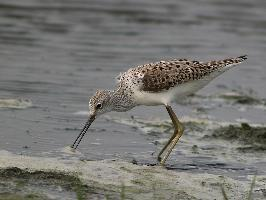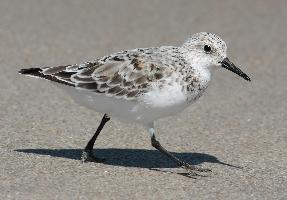
Állatleírás
The Green Sandpiper (Tringa ochropus) is a fascinating and somewhat elusive wading bird that belongs to the family Scolopacidae, which includes other shorebirds such as sandpipers, snipes, and phalaropes. This species exhibits several unique features and behaviors that distinguish it from other members of the sandpiper family, making it a subject of interest for birdwatchers and ornithologists alike.Physical Characteristics:
The Green Sandpiper is a medium-sized bird, typically measuring about 20-25 cm in length, with a wingspan of approximately 40-44 cm. It possesses a slightly upturned, slender bill that it uses adeptly for probing in mud and shallow water for food. Its plumage is a distinctive blend of colors and patterns. During the breeding season, the bird showcases a dark greenish-brown back, with each feather edged in a paler tone, giving it a scaled appearance. The underparts are white, vividly contrasted with a boldly streaked and spotted neck, breast, and flanks. In non-breeding plumage, the bird's colors are somewhat muted, but it still retains the characteristic patterns that make it identifiable. Its legs are a greenish-yellow, providing a subtle hint to its common name, and its eyes are bright and alert, surrounded by a white ring.
Habitat and Distribution:
Green Sandpipers are migratory birds, breeding across parts of Europe and Asia, particularly favoring the boreal and taiga zones. Unlike many other wading birds that prefer coastal areas, Green Sandpipers are more often found inland, near freshwater bodies such as rivers, lakes, marshes, and swamps. They exhibit a strong preference for wooded areas, often nesting in old trees, utilizing the abandoned nests of other birds such as thrushes. During the winter months, they migrate southwards to warmer climates, reaching parts of Africa, the Indian subcontinent, and Southeast Asia. During this period, they can be found in a wider variety of wetland habitats, including estuaries and mangroves, although they still show a preference for freshwater environments.
Behavior and Diet:
The Green Sandpiper is a solitary bird, although it may form small flocks during migration. It is known for its distinctive bobbing motion, a behavior common to many sandpipers, where the bird rocks its body back and forth while standing. This species is more secretive and less vocal than some of its relatives, often heard before it is seen, with a sharp, whistled "tew-tew-tew" call that alerts others to its presence.
Its diet consists mainly of insects, small crustaceans, and other invertebrates, which it hunts by sight, pecking them from the surface of mud or shallow water. The bird's keen eyesight and sensitive bill allow it to detect and capture prey efficiently, even in murky conditions.
Reproduction:
The breeding season for the Green Sandpiper typically begins in late spring or early summer. It is a unique species among waders because it does not build its own nest on the ground but instead uses the old nests of songbirds, particularly those located in trees, a behavior almost unheard of among other sandpipers. The female lays a clutch of usually four eggs, which are incubated by both parents for about three weeks. The chicks are precocial, meaning they are relatively mature and mobile from the moment of hatching. They leave the nest shortly after birth to follow their parents, who guide them in foraging for food.
Conservation Status:
Currently, the Green Sandpiper is classified as Least Concern by the International Union for Conservation of Nature (IUCN), indicating that it is not currently at significant risk of extinction in the wild. However, like many migratory bird species, it faces threats from habitat destruction and degradation, particularly in its breeding and wintering grounds. Conservation efforts aimed at preserving wetland habitats are crucial for ensuring the long-term survival of this and many other wading bird species.
In conclusion, the Green Sandpiper is a remarkable bird, with its distinctive appearance, intriguing behaviors, and unique nesting habits. Its presence enriches the biodiversity of the wetlands and serves as a reminder of the importance of conserving these vital ecosystems for the future.
Hasonló állatok
Új állatfotók
Top 10 állat
- Dolphin gull (Leucophaeus scoresbii)
- Diana monkey (Cercopithecus diana)
- Moustached guenon (Cercopithecus cephus)
- Galápagos tortoise (Geochelone nigra complex)
- Japanese macaque (Macaca fuscata)
- Russian tortoise (Testudo horsfieldii)
- Stone loach (Barbatula barbatula)
- Greek tortoise (Testudo graeca)
- Common flying dragon (Draco volans)
- Vendace (Coregonus albula)


